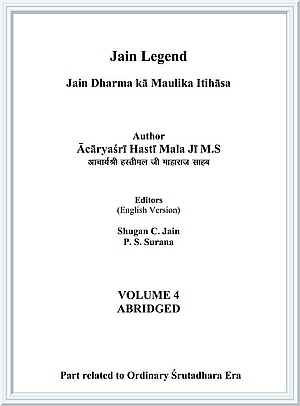One day Kumārapāla inquired Āliga, his chief councillor, an aged priest, who sat beside him in the palace, "O Honourable Priest! Please tell me, am I inferior or superior or equal to King Siddharāja Jaya Siṃha in virtues (guṇas)?"
The royal priest thought for a while and replied, "O King of Kings! Since you have asked I am obligated to tell the truth. Please forgive me. King Siddharāja had 96 virtues and 2 vices; on the contrary you have 2 virtues and 96 vices."
The royal priest Āliga was famous in Gurjara kingdom for his honesty. Kumārapāla also knew that Āliga never hesitates to tell the truth even in the presence of anyone. So, when Āliga clarified that he has 96 vices, Kumārapāla despised himself. He took out his dagger off the sheath and was about to pierce his eyes with it, the royal priest in lightning speed rushed to him and holding his hands tightly said, "O King! You have not yet listened to me completely. It is true that Siddharāja had 96 virtues but he lacked chivalrous fortitude and was given to lasciviousness. These two grave vices eclipsed his 96 virtues. On the contrary you have 96 vices-mean qualities like stinginess etc. Nevertheless your valour in the battle-field and your concept of 'Mātṛvat Paradāreṣu'- treating other women like your own mother and sisters, these two great virtues overshadow all your 96 vices."
Kumārapāla felt delighted with his clarification and kept the dagger back in the sheath.
This small incident not only illustrated his great qualities which should be followed by one and all but also exhibits the fact that he was a sin fearing, ardent theist and was always ready to undergo contrition for his wrong deeds.
When Kumārapāla saw his preceptor prepared to leave for heaven observing fast unto death he was moved with grief. For him ācārya was a great pillar, who moulded his character with great vows like nonviolence, truth, non-stealing, celibacy (in the form of fidelity towards wife), who generously sowed the seeds of the three gems of Right Faith, Knowledge and Conduct in the hearts of one and all and who practiced and preached the great doctrine of universal brotherhood. This king who stands firmly in the front of the firing line in any fierce battle leading his quadripartite army, and who with undaunted courage crosses swords with formidable foes, was now engulfed by great sorrow at the sight of his preceptor's last journey. His eyes were filled with tears. Seeing that his disciple was mourning, Hemacandra Sūri consoled him, "O King! The last form of union is separation and the last stage of birth is death. They are indispensable and definite. So it is futile to ponder over and grieve at the things that are bound to happen. You not only served the Jina order promoting its doctrine dedicatedly by decreeing ordinance against animal slaughter and constructing Vihāras, but also disentangled your way in this world and in the world above. Nonetheless, very soon you will also follow me. So discard lamentation and engage the rest of your life in the service of Jina Order". Thus preaching Kumārapāla, his disciples and followers to dutifully serve Jina Order, Ācārya Hemacandra Sūri left for heavenly abode in samādhi in Vikram 1229.
King Kumārapāla performed his Guru's funeral rites in royal honour. Taking the burnt ash with adoration, he applied it on his forehead. Following the example of the king, the feudatories, ministers and thousands of people who attended the funeral ceremony applied the ash on their foreheads. As a result a chasm formed over there and the citizens of Paṭṭaṇa called it as 'Hemakhaṇḍa'.
Kumārapāla could not bear the separation of his preceptor. With tears flowing on to the cheeks and with a choked voice he addressed his feudatories and ministers, "My only distress is I could not even offer a drop of water to my guru, what to talk of food, as he always abstained from Rājapiṇda (food offered by kings)".
Thus always reminiscent of the fond memories of his Guru and adhering to his instructions, Kumārapāla engaged himself in the service of Jain Order. Eventually 'Paramārhata' Kumārapāla left the mortal body in Vikram 1230 in Samādhi contemplating and confessing his sins.
 Acharya Hasti Mala
Acharya Hasti Mala
